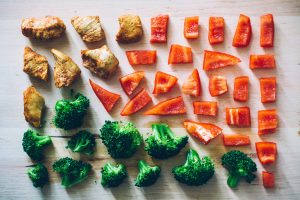 Eating healthy doesn’t normally come naturally. It’s tough to break old habits of carry-out, quickie meals and sugary snacks. That’s why setting goals, planning meals ahead and preparing them ahead is a huge benefit. If all you have to do is warm and serve, you’ll be more apt to eat healthier, especially when you’ve had a long day. This beginner’s guide to food prep can help you start your program of healthy eating and eliminate some of the pitfalls.
Eating healthy doesn’t normally come naturally. It’s tough to break old habits of carry-out, quickie meals and sugary snacks. That’s why setting goals, planning meals ahead and preparing them ahead is a huge benefit. If all you have to do is warm and serve, you’ll be more apt to eat healthier, especially when you’ve had a long day. This beginner’s guide to food prep can help you start your program of healthy eating and eliminate some of the pitfalls.
If you aren’t already using a healthy eating meal planning program, create your own.
Take an hour to scan the grocery sales and include the in-season fruits and vegetables when you plan your meals. Once you identify the primary ingredients you’ll use, find healthy recipes that store well for your weekly menu. If you’re buying a special ingredient, such as fresh cilantro, find a recipe that uses it for other meals if you want it fresh or freeze it in ice cube trays and use it in cooked recipes later. Nothing will go to waste when you plan. Fresh fruits and vegetables make great snacks and can be used in recipes throughout the week. Anything left over makes a great soup.
Make shopping a once a week job you do after you eat.
Whether you shop at night or during the day, don’t do it without eating first or you’ll find your cart filled with impulse options, like sweet treats or crunchy chips. Take your shopping list with you. It should include all the ingredients you need for the meals and for snacks. Snacks play an important role in healthy eating. They help prevent overeating at meal time or grabbing a quick candy bar or sweet treat between meals. Get the kids involved in helping you choose the snacks, but do it when you’re planning meals, not at the grocery. You can narrow their choices by allowing them to pick the fresh fruit, healthy dip or vegetables to serve as snacks. Ants on a log, celery filled with peanut butter with raisins dotting the top, or yogurt with fresh fruit, are examples of choices.
Take two days to devote to the weekly cooking.
If you’re working outside the home during the week, use the weekend for your cooking spree. Make double the recipe, so you have some to eat during the week and meals to store for another week. At first, you’ll have to cook all the meals in two days, but eventually, you’ll have enough stored up to cut cooking to one day and plenty of meals ready to eat in the freezer.
- When you make meals ahead, you’ll have plenty ready to heat and serve. You can even create one free day when the family gets to pick out exactly what they want to eat from the stored food.
- Label your frozen foods with the name of the food and the date stored. It’s easier to have portion control when you buy divided meal containers for meal storage.
- There’s never any waste if you plan ahead. Instead of throwing out, store some leftovers that aren’t used in freezer bags and when you have enough, make soup! If you make a rotisserie chicken in your air fryer, use the bones for bone broth.
- Creating healthy snacks isn’t hard and it also cuts down on meal prep time. Wash up fresh fruits and vegetables and have them ready in eat in bite size pieces. They provide snacks and the ready ingredients for a healthy stir fry or other menu option.
